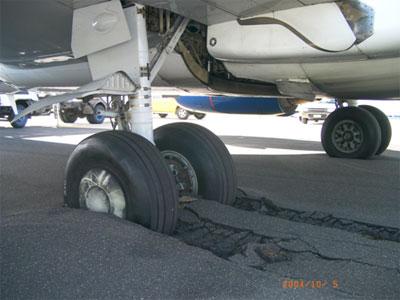Sequence of events
At 1940 eastern standard time (EST), on 4 October 2004, the Boeing Company 737-300 aircraft, registered ZK-FDM, became bogged (Figure 1) at Melbourne Airport. The aircraft was being taxied to runway 27 for a scheduled international passenger service to Hamilton, New Zealand.
Figure 1: Left main landing gear tyres after penetrating the blast-protection surface adjacent to taxiway Papa.

The flight crew commenced taxiing the aircraft to runway 27 from bay 'Delta 4' at the international terminal. Taxiing to Papa1 via Tango was not available because of the stage A2a works in progress on the northern apron (depicted at Attachment 1), and the surface movement controller (SMC) instructed the crew to taxi the aircraft via Sierra and Echo to the runway 27 holding point on Papa. As the aircraft approached Sierra the crew requested confirmation of the taxiing instructions, and the SMC repeated those previously given. The SMC then told the crew to contact the aerodrome controller (ADC) on frequency 120.5 MHz.
The flight crew subsequently reported that while taxiing east along Echo, their attention had been drawn to the lighting associated with the apron works near the intersection of Tango and Papa. There was a holding bay located north of Echo, and the first lead-in light to the holding bay was about 40 m west of the first lead-in light to Papa. As the aircraft approached the lead-in lights to the holding bay, the pilot in command stopped the aircraft. The copilot asked the ADC "is it hard left Papa here?"
The ADC was located in the aerodrome control tower, which was about 1,450 m to the west-southwest of the aircraft's position. From the ADC's vantage point, and in the night conditions, the aircraft would have appeared to have been at the lead-in to Papa, and the ADC confirmed to the crew that it was Papa.
The pilot in command, in response to the advice from the ADC, turned the aircraft left and began to enter the holding bay, thinking it was taxiway Papa. It then became obvious to the crew that they were not on Papa, and the pilot in command turned the aircraft to the right to regain taxiway Echo and the lead-in to Papa. He subsequently reported that another aircraft taxiing on Quebec for runway 27 had its lights 'very brightly shining', and that he misidentified the double lines on the taxiway shoulder as being the taxiway centreline. As a result, the pilot in command inadvertently steered the aircraft onto the blast-protection surface adjacent to the taxiway shoulder pavement. The left main landing gear tyres of the aircraft penetrated the blast-protection surface, and the aircraft became bogged.
The aircraft could not be moved from its bogged position, and the 104 aircraft occupants, which comprised two technical crew, three cabin crew and 99 passengers, were disembarked and taken back to the international terminal.
The aerodrome operator reported that all airside signs, markings and lights complied with ICAO standards and CASA regulations, and that they were serviceable and operating normally at the time of the occurrence. The circumstances of the occurrence did not suggest that there were any deficiencies in the aerodrome airside signs, markings and lighting systems.
The aircraft weight and balance data for the planned flight revealed that its taxi weight was 54,434 kg, and the centre of gravity was at 20.4 percent mean aerodynamic chord. Under those conditions, about 90 percent (49,500 kg) of the aircraft's total landing gear pavement load was exerted by both the main landing gears, that is, each main landing gear pavement load was about 24,750 kg. The left main landing gear pavement load was of sufficient magnitude to result in the left main landing gear tyres penetrating the blast protection surface.
The aircraft was recovered from its bogged position on the following day and subjected to a heavy landing engineering inspection. The inspection revealed no damage resulted from the incident, and the aircraft was returned to service.


